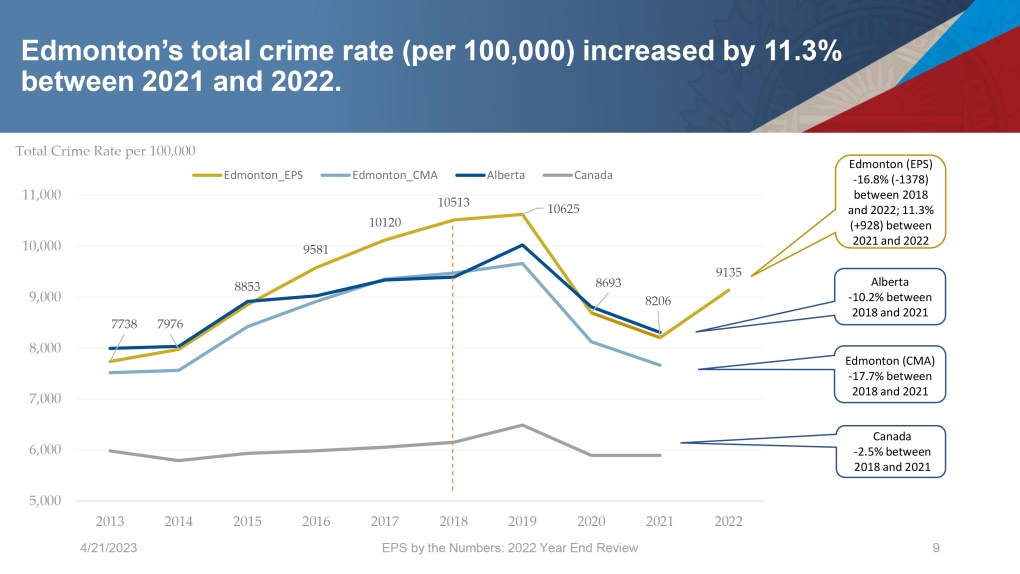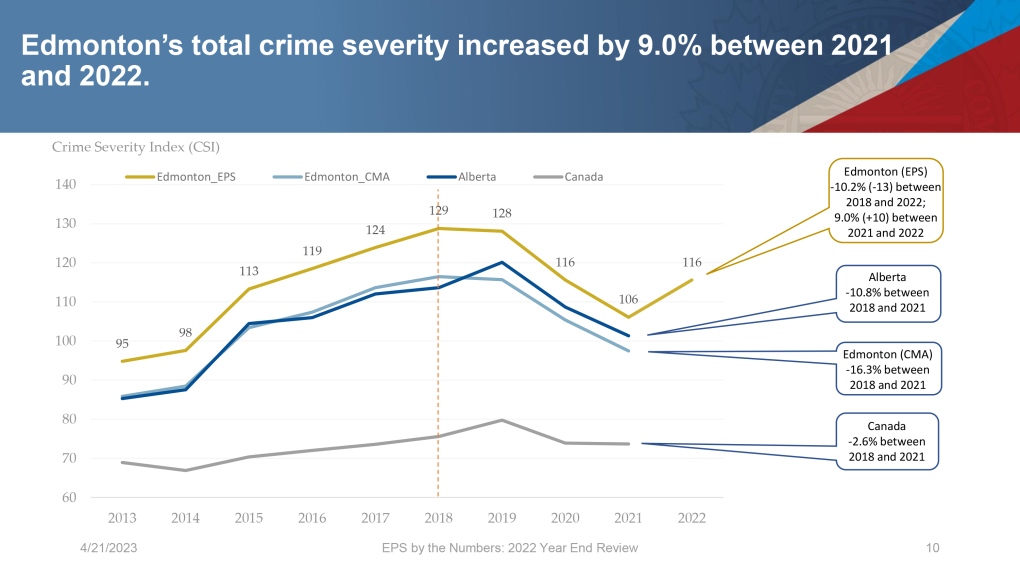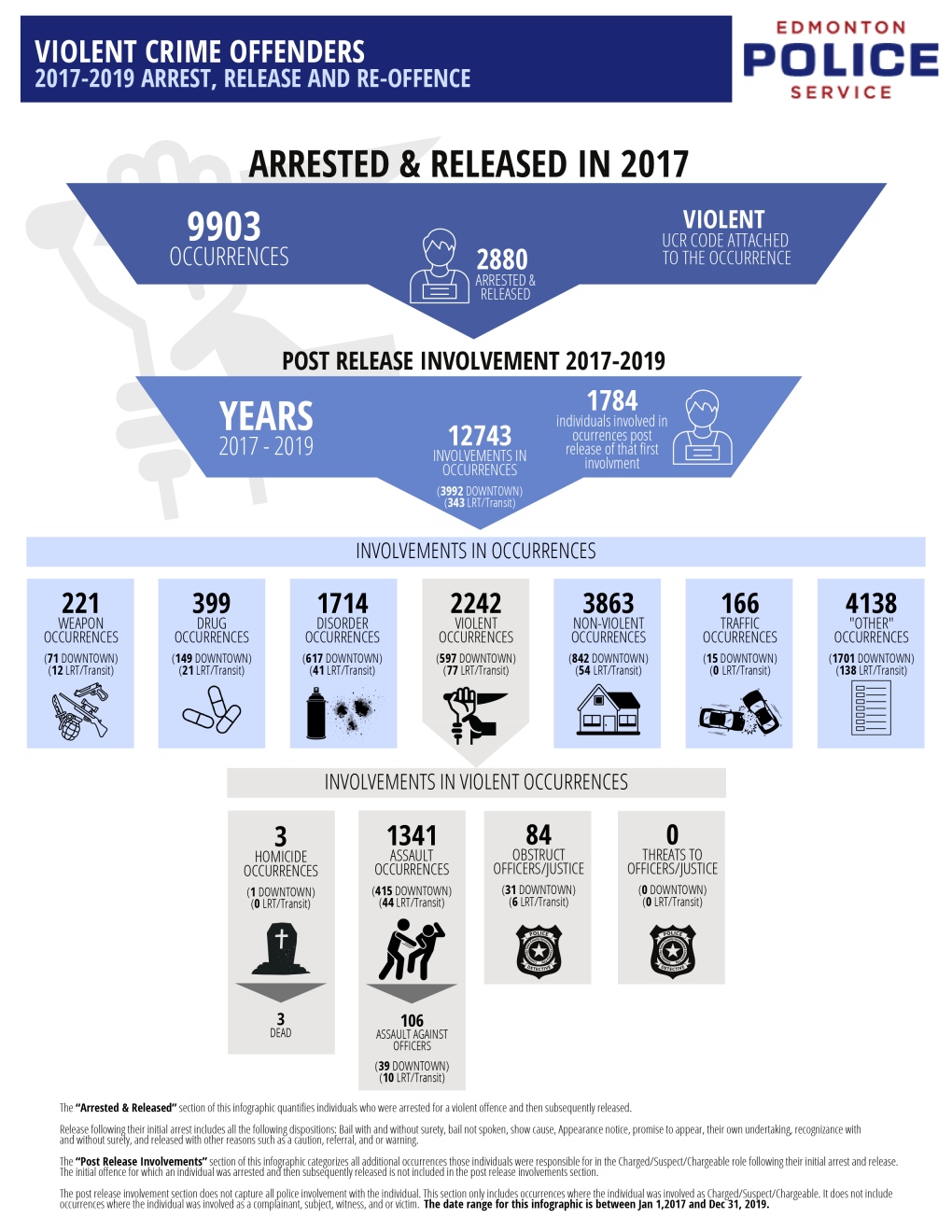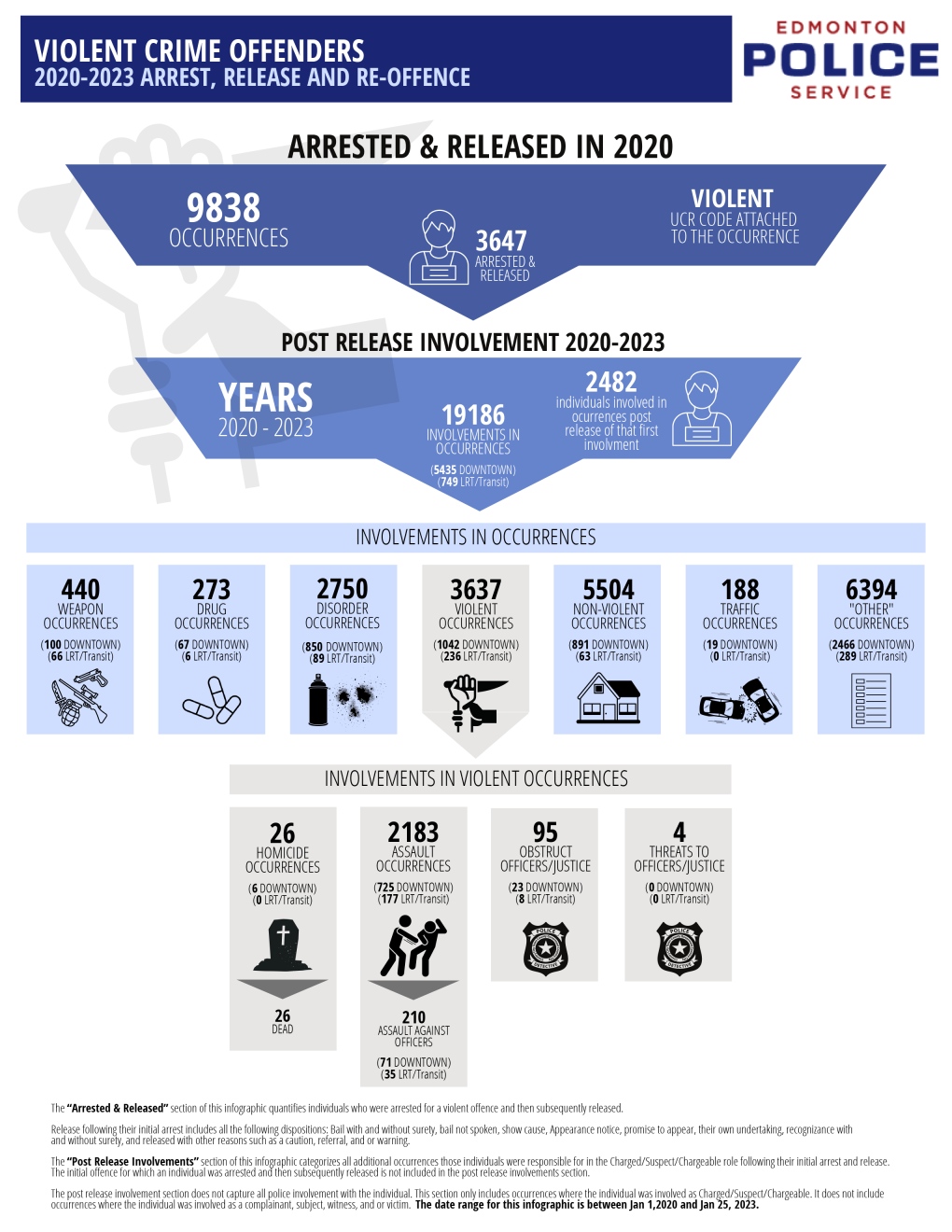2022 saw more violent crimes in Edmonton than any other year: police
More violent crimes were reported in Edmonton in 2022 than any other year, new numbers released by the Edmonton Police Service show.
In a presentation to reporters on Friday morning, Sean Tout, executive director of the EPS Information Management and Intelligence Division, laid out the numbers.
"Violent victimization, the volume of violent crime, and the severity of violent crime, and violence perpetrated against these victims continues to increase in the City of Edmonton at alarming rates," he told reporters.
"In fact, 2022 represents the highest number of violent criminal incidents ever reported in a single year, and this trend continues to escalate in '23."
Tout says in Q1 of 2023, violent crimes are up 6.1 per cent from Q1 of 2022.
The violent crimes that saw the most increases in 2022 from 2021 are as follows:
- Assault level 1 - up 32 per cent (+1,141 incidents)
- Assault level 2 (weapon/bodily harm) - up 14 per cent (+413 incidents)
- Robbery - up 22 per cent (+214 incidents)
- Incident/harassing communications - up 45 per cent (+213 incidents)
The violent crimes that saw the biggest decrease in 2022 include:
- Uttering threats - down seven per cent (-99 incidents)
- Sexual assault - down five per cent (-65 incidents)
- Assault against a peace officer with a weapon or causing bodily harm - down 46 per cent (-37 incidents)
- Obtaining sexual services for consideration - down 59 per cent (-26 incidents)
- Kidnapping - down 50 per cent (-25 incidents)
GUN, LRT VIOLENCE
Tout said incidents involving the presence or use of a firearm increased by 25 per cent in 2022 (+82), a trend he says continues to escalate in 2023.
"Between January and March of this year, there has been an increase of 75 per cent, or 24 additional victims, injured or killed by firearms in comparison to the same time period last year."
Crimes involving knives also increased 9.8 per cent (+83) in 2022, but Tout says those crimes decreased by 11 per cent, or 11 fewer victims in Q1 of 2023.
In 2022, Tout said calls for service to LRT or transit centres increased 28.7 per cent, up 450 calls.
Calls for service in downtown increased by 2.6 per cent (+830).
The total number of criminal incidents within downtown jumped by 7.7 per cent (+1,153), and the total number of violent criminal incidents downtown saw an 8.4 per cent (+247) increase.
TOTAL CRIME RATE AND CRIME SEVERITY INDEX
Edmonton's total crime rate (per 100,000) jumped by 11.3 per cent, or an additional 928 incidents in 2022.
A graph prepared by the EPS shows Edmonton's rate is well above the national average.
 Edmonton total crime rate for 2022. (Source: EPS)
Edmonton total crime rate for 2022. (Source: EPS)
The crime severity index also increased by nine per cent in Edmonton in 2022, also well above the national average.
Tout added Edmonton saw a decrease in the crime severity index between 2018 and 2022 before the number spiked in 2022.
 Edmonton's crime severity index for 2022. (Source: EPS)Edmonton's violent crime rate (per 100,000) saw a 16.5 per cent spike, or an additional 201 incidents in 2022, and the violent crime severity index increased by 5.4 per cent.
Edmonton's crime severity index for 2022. (Source: EPS)Edmonton's violent crime rate (per 100,000) saw a 16.5 per cent spike, or an additional 201 incidents in 2022, and the violent crime severity index increased by 5.4 per cent.
Citywide, Tout said 36.5 per cent of victims of violent crime don't know the person who victimized them.
RELEASE AND RE-OFFENCE
The association that represents Canada's police chiefs is expected to meet with provincial and territorial premiers on Friday to talk about reforming Canada's criminal justice system.
Tout discussed some of the issues that led to the call for the meeting.
In 2018, the federal government passed Bill C-75, which made changes to the federal bail system.
Tout presented some data to show the number of offences committed by people who were released from custody after committing a violent crime before the bill was passed, and after. The numbers were compiled by the EPS Analytics and Intelligence branch.
Tout said the EPS looked at 2,880 people who were arrested in 2017 for violent crimes, and subsequently released.
He said 1,784 of those individuals went on to commit a total of 12,743 offences between 2017 and 2019, including three homicides.
 Subsequent to the introduction of Bill C-75, Tout said EPS identified 3,647 individuals who were arrested for violent crimes in 2020.
Subsequent to the introduction of Bill C-75, Tout said EPS identified 3,647 individuals who were arrested for violent crimes in 2020.
He said between 2020 and 2023, 2,482 of those individuals went on to commit a total of 19,186 offences, including 26 homicides.

"You can see the differences in the volume and the severity of post-arrest, release, and re-offence conduct in comparison to the three years prior to 2020 and the three years post 2020," he said.
Tout said police do not have a full picture of how many violent criminals reoffend after release, because the police, justice, and corrections information systems are not linked.
"We know we have a small number of individuals disproportionately responsible for a large number of the volume of occurrences. That equates to a large resource draw in identifying these individuals and holding them to account."
"While we have some ability to reach out and get pieces of that information, we don’t have that overarching, full system view."
He said he hopes the meeting will result in a link between the data systems.
Tout also acknowledged that social, health, and economic impacts of the pandemic could also have resulted in the increase in re-offences.
"Absolutely there are impacts associated to pandemic as it relates to the pandemic, all for the right reasons. But there’s an opportunity in us here now taking a look at the results of all of those decisions and all of those policies."
'THEY WILL COME OUT AT SOME POINT'
One criminologist says while the data is important, the concepts the police are trying to impart by releasing it are not new.
"Clearly we have a lot of work to do. The violent crime rate is up, and it's up in specific areas of the city," University of Alberta criminologist Temitope Oriola told CTV News Edmonton. "But I would also emphasize that the idea that crime is non-randomly distributed is again, not new. We've known for decades that certain spaces, social spaces, produce more volumes of crime. So I see an attempt to produce it as a sort of novelty."
Oriola wants the police to be specific about what they want lawmakers to do with the data.
"What is the EPS's recommendation? What do you want our elected leaders to do about this crime wave?"
"It does seem that what the EPS and other police services across Canada are suggesting is for harsher and lengthier, longer sentences."
Oriola said such punishments aren't a new concept either, and studies have shown while they may work initially, there are diminishing returns within a few years.
"Why? Because it leaves unaddressed the root causes," he said.
"The essence of the criminal justice system is not to lock people up indefinitely. They will come out at some point. The question is what do they come out to?"
He added skills programs for people in prison, post-incarceration housing arrangements, and mental health and addictions supports all play a large role in reducing crime.
Oriola said creating a strong social support network now for future generations will also reduce crime.
"Those who are in regular and sustained interactions with the police, including those suspects from those numbers aggregated in the data released by the EPS are individuals who have largely had adverse childhood experiences," he said, naming childhood poverty, homelessness, and drug addictions as factors.
"Incarceration has to be one of multiple measures, especially social measures, that we put in place."
With files from CTV News Edmonton's Jeremy Thompson.
CTVNews.ca Top Stories

W5 Investigates 'It's a bad look': Calls grow to restrict high-tech car theft devices in wake of W5 investigation
There are new calls to crack down on the sale of high-tech devices that can be used to clone key fobs and steal cars, in the wake of a W5 investigation that found the devices are falling into the hands of thieves.
Jake Paul beats 58-year-old Mike Tyson as the hits don't match the hype
The boos from a crowd wanting more action were growing again when Jake Paul dropped his gloves before the final bell, and bowed toward 58-year-old Mike Tyson.
Former ambassador says Canada has become 'laggard,' 'irrelevant' on defence spending
Former Canadian ambassador to the U.S. Derek Burney is calling Canada a 'laggard,' and says the country needs to do 'major work' on its defence spending if it wants to be taken seriously on other issues with the United States.
'My heart sank': B.C. farmers devastated by avian flu
For Mark Siemens, one of the worst things is the smell. The third generation farmer in B.C.’s Fraser Valley is still grappling with what started as a disturbing discovery on Halloween and has now ended with the loss of his entire 45,000-bird flock.
What the spritz is 'smellmaxxing?' Why so many teen boys smell like a million bucks
It's a growing trend online: fragrance influencers who rave about the beauty, sexiness and notes of vanilla in perfume have caught the attention of Canadian teenagers who are, in turn, flocking to cologne counters across the country.
Former soldier 'Canadian Dave' taken by the Taliban: sources
David Lavery, a former Canadian Forces soldier who helped approximately 100 people flee Afghanistan during the fall of Kabul, has been 'picked up' by the Taliban this week, according to multiple sources who spoke to CTV National News on the condition of anonymity.
Canada Revenue Agency eliminating nearly 600 term positions by end of 2024
The Canada Revenue Agency will be eliminating approximately 600 temporary and contract employees across the country by mid-December.
Montreal road rage caught on video: Suspect charged with assault causing bodily harm
A 47-year-old Terrebonne man has been charged following a case of road rage in broad daylight last summer on the Ile-aux-Tourtes bridge.
Alta. Premier Danielle Smith will be in Washington for Trump inauguration
Alberta Premier Danielle Smith will be heading to Washington, D.C., for Donald Trump's presidential inauguration.


































